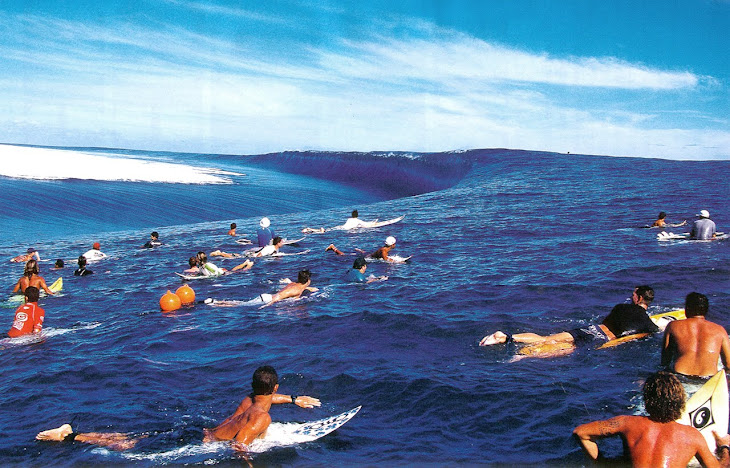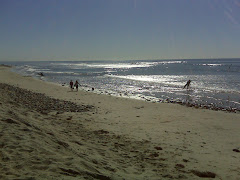
START TO MOVE ON THE BOARD KNEE CHEST HIGH WAVES:
big(ish) waves on a longboard
Postby jimmynitcher on Sat Oct 13, 2007 8:40 pm
Hi,
I've just got to a stage where I am turning for the first time and trimming along nicely, it's a fantastic feeling and I well and truly hooked (age 48 btw, no probs, getting younger everyday!)
My first board - I've got a Custard Point all rounder (9'6") with thrusters and when it gets shoulder high I start nosediving before I can turn or I just drop off the face.
Are there any particular things I should be doing when it gets a bit bigger?
cheers people
j
jimmynitcher
Posts: 19
Joined: Sat Oct 13, 2007 8:20 pm
Top
Re: big(ish) waves on a longboard
Postby hughesy on Sat Oct 13, 2007 9:44 pm
Work on your wave selection and concentrate on getting into the wave early. The beauty of longboards is you can paddle in early making the take off less critical. The idea put about by some people that longboards are only any good in little stuff is crap, they don't realy come alive till the waves are shoulder high at least.
User avatar
hughesy
Posts: 499
Joined: Thu Aug 18, 2005 8:37 pm
Location: a spec in the distance
Top
Re: big(ish) waves on a longboard
Postby Poo Stance on Sun Oct 14, 2007 7:01 pm
"concentrate on getting onto the wave early" ....
he means, sit further out back and try and catch the wave as its building rather than at a more critical point (ie. not so close to the time the wave breaks).
with a bigger board you can paddle faster but it takes a couple more strokes to get up to speed. Bigger waves travel faster so you need to start stroking a bit earlier, but you dont want to do this if your sitting too far inside, so sit out back further.
Just one point tho, if your doing this it means you can 'steal' alot of waves of the shortboarders who need to sit more inside in that critical place. This is when you need to show some respect to those who choose to ride shorter boards and realise when you've caught more waves than others in the water around you. Ie. try and keep an eye out on how many waves other people are taking. which can be hard if its crowded. Another way is to let a few waves go, just put your hands up and let people know you are not attempting to catch every wave. You will make alot of friends this way and have a more enjoyable surf, as will everyone else.
Paddling earlier should get you onto the wave nice and early and you can then stand up way before the wave breaks and gets too steep, thus eliminating the nose diving lark.
Remember, share the love, share the waves or you will eventually piss someone off.
hope this helps. enjoy :)
User avatar
Poo Stance
Posts: 1762
Joined: Mon Oct 03, 2005 2:07 pm
Top
Re: big(ish) waves on a longboard
Postby Chewbecca on Sun Oct 14, 2007 9:57 pm
To be honest, it sounds like you are doing something wrong, because there is no reason you shouldn't be able to drop into big steep waves on a longboard. If you're nosediving then maybe you are popping up to far forward (or too late) or not getting back quick enough?
To get yourself started in the bigger stuff try angling your takeoff (ie turning while you paddle just before the wave gets to you) so that you are already going in the right direction as you take off. Much less risk of nosediving or screwing up your turns that way.
User avatar
Chewbecca
Posts: 3104
Joined: Thu Feb 03, 2005 9:53 pm
Location: Newquay - coast of dreams
* Website
Top
Re: big(ish) waves on a longboard
Postby jimmynitcher on Tue Oct 16, 2007 9:08 pm
All good ideas - the point about not taking them all is a good one too, I try to be as respectful as possible, as an 'intermediate/learner' I have only just felt confident enough to be amongst the crowd, I have up till now been well away from people losing out on the best sections as a result.
Anyhoo I killed two birds with one stone: the other day I had my best session ever by taking off earlier and paddling harder , it meant I needed to rest longer, allowing others onto plenty of good stuff so I'm really grateful to your help folks.
j
jimmynitcher
Posts: 19
Joined: Sat Oct 13, 2007 8:20 pm
Top
Re: big(ish) waves on a longboard
Postby mateusferianci on Wed Oct 17, 2007 2:00 am
Helo everybody!
I´m looking to buy a used surfboard, couse I will saty a month in Cape Town, There is anyone who could help me to do it?
thanks
Mateus
mateusferianci
Posts: 3
Joined: Wed Oct 17, 2007 1:35 am
Top
Re: big(ish) waves on a longboard
Postby weaver on Wed Oct 17, 2007 10:59 am
Just to keep your stoke up jimmy one day this will happen to you. You've read the wave right, paddled early and hard and the board's sitting just off the shoulder and pretty flat on a chest high wave. You'll pop and lo and behold you're standing on a board that's perched like a see saw on top of clean wave with one foot behind the crest and the other in front of it. Your board's still moving forward and you've got all the time in the world and you'll KNOW that all you have to do is make one little cross step with your back foot for a fraction of a second and the board will tilt down the face. What happens next is the stuff of dreams. With all that planing surface on a long board it'll take off like a rocket straight down the face and at the end of the drop all you'll have to do is make a tiny weight shift across the board and you're into a howling, carving turn off the rail. Have a look at Bonga Perkins taking the drop in "Single Fin Yellow" (even he wipes at the first attempt) if you get a chance......................stay stoked............. :-D
Speed of a racehorse, strength of a carthorse, brains of a rocking horse.
User avatar
weaver
Posts: 1067
Joined: Mon Jun 26, 2006 6:12 pm
Location: Twilight
Top
Re: big(ish) waves on a longboard
Postby jimmynitcher on Sat Oct 20, 2007 8:27 am
Now THAT is what I'm after!
Does the cross step mean you switch from goofy to regular? I'd better see the film.
I get the odd glimpse sometimes but its more luck than design at the mo and the position of my feet is still a bit of a mystery, I'm trying all sorts of variations and trying to log the results in my mind, sometimes I see people turning with a really narrow stance and it seems to be more about leaning, which I'm a bit crap at.
All good fun, thanks for the help and encouragement!
j
jimmynitcher
Posts: 19
Joined: Sat Oct 13, 2007 8:20 pm
Top
Re: big(ish) waves on a longboard
Postby weaver on Sat Oct 20, 2007 9:09 am
jimmynitcher wrote:Now THAT is what I'm after!
Does the cross step mean you switch from goofy to regular? I'd better see the film.
I get the odd glimpse sometimes but its more luck than design at the mo and the position of my feet is still a bit of a mystery, I'm trying all sorts of variations and trying to log the results in my mind, sometimes I see people turning with a really narrow stance and it seems to be more about leaning, which I'm a bit crap at.
All good fun, thanks for the help and encouragement!
j
Think of it as standing on a see saw with one foot either side of the pivot and everything balanced. I'm regular so to make the thing tilt I make a single cross step with my right foot, left foot does'nt move, sqeeze down onto the right foot and as the nose goes down right foot goes back to where it was. I get the narrow stance thing towards the end of a session when arms and legs are getting tired but like I said if you've got the speed you'll turn off the rail with hardly any weight shift. If you're not travelling that fast try putting short, small rocks onto toes or heels so you don't overbalance and instead of making a long carving turn you'll make a series of smaller ones. Works for me................. :-)
Speed of a racehorse, strength of a carthorse, brains of a rocking horse.
User avatar
weaver
Posts: 1067
Joined: Mon Jun 26, 2006 6:12 pm
Location: Twilight
Top
Re: big(ish) waves on a longboard
Postby jimmynitcher on Sat Oct 20, 2007 2:28 pm
Thanks, its great to be able to get the details, watching people is kind of inexact.
Speed is critical isn't it ? At the moment I kind of shuffle forward as quiick as poss to if I feel it stalling, but a cross step maybe better, do you step in front or behind the front foot?
I actually got to the pivot point on top of one today but I saw a couple of people dawdling in front of the wave and I put the weight on the wrong foot and reversed back over the wave! Not my most glorious moment, that came later when I rode high up on one for ages and I could see another 50 yards of it ahead when someobody actually dropped in in me, boy was I pissed off, but didn't show it as I still feel like an imposter for some reason, the guy apologised so at least he knew, but it would have been a great last one of the day, I tried to find another like it for another half hour and of course nada, strange feeling of being robbed!
ah well there's always tomorrow









































